
The variegated rubber plant, known as Ficus elastica tineke or Ficus tineke, is one of the prettiest plants of this year. A sister to Ficus elastica, Ficus tineke is basically an impressionist rubber tree; pink painted leaves with white and green, these babies are beautiful.

Some of you may already know my big boi Rudy the Rubber tree, who was my first real plant and began my deep spiral into plant parenthood. I rescued Tilda in 2017 shortly after. Spindly and sad, she was glued into a Mother’s Day vase, sold as a “succulent” with fake rocks and crummy soil. Tilda’s recovered but has grown only a few inches since then. I’ll add that Rudy is well over 5′ tall.
Ficus Tineke vs Ficus Ruby
Real quick I just want to clear up some naming issues. First, “Ficus tineke” is the overall name for the variegated rubber tree. Also called Ficus doescheri, it looks aesthetically like the plant in the photo above – with a little red/pink in the leaves. The Ficus tineke “ruby”, sometimes called Ficus ruby, is basically the same plant, just with more pink in the mature leaves (see below). Whether Ficus ruby, variegated Rubber tree, Rubber fig tree, Ficus doescheri, or Ficus tineke they are all the same plant. If you’re completely new to Rubber plants, I strongly suggest reading this post about them, but if you’re here for just Ficus tineke info, I strongly suggest you still read this post.
Basic Care
I’ll be upfront about this, I find Ficus tineke a bit fussier than plain Rubber trees. Variegation tends to make plants’ needs higher and grow slower since they lack chlorophyll. I also find tineke a bit more susceptible to pests and general issues, but who cares they’re really pretty.
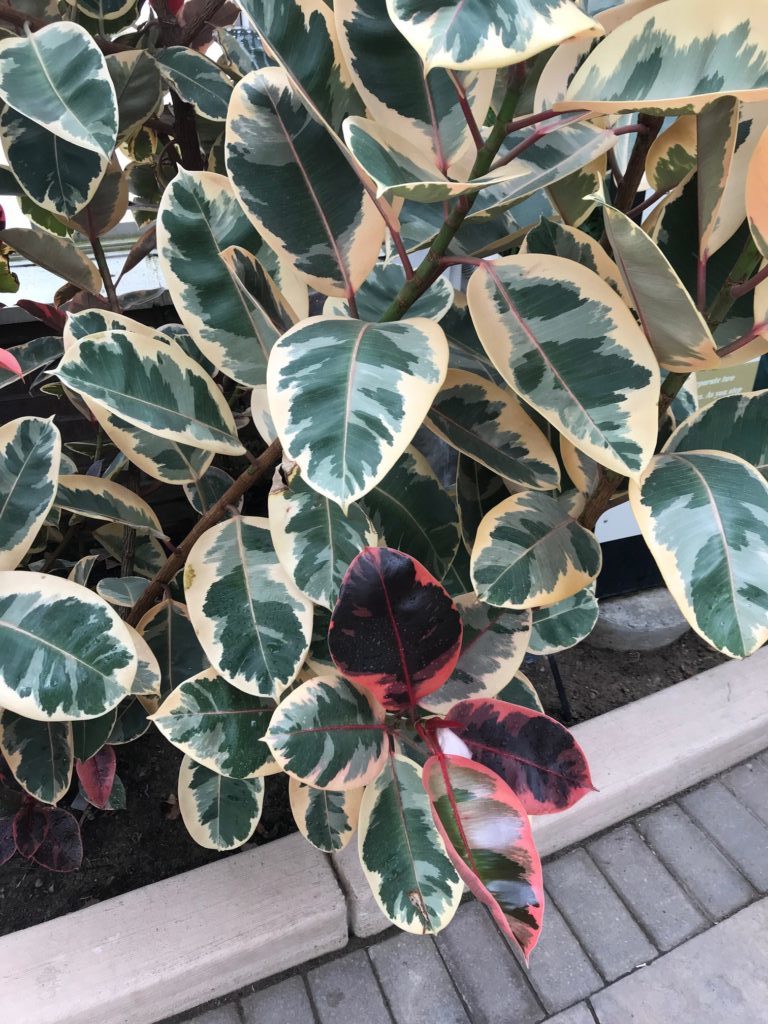
Sunlight: Variegated rubber plants like bright light but cooler temperatures. In fact, many variegated plants prefer cooler temperatures – that’s what creates more variegation. Bright, daily sunlight is necessary but harsh direct sun can damage their fragile leaves. I like to keep all variegated plants a few feet away from windows so they get the light without any possibility of sizzling.
Watering: A horrible offender of rubber trees is overwatering. More often than not, this is the cause of death. It is horribly difficult for a rubber tree (or any plant, really) to bounce back after a perpetual soggy bottom. Let Ficus elastica dry out a bit between waterings; I water all of them once a week. Tilda and Rudy live in Southwest windows.
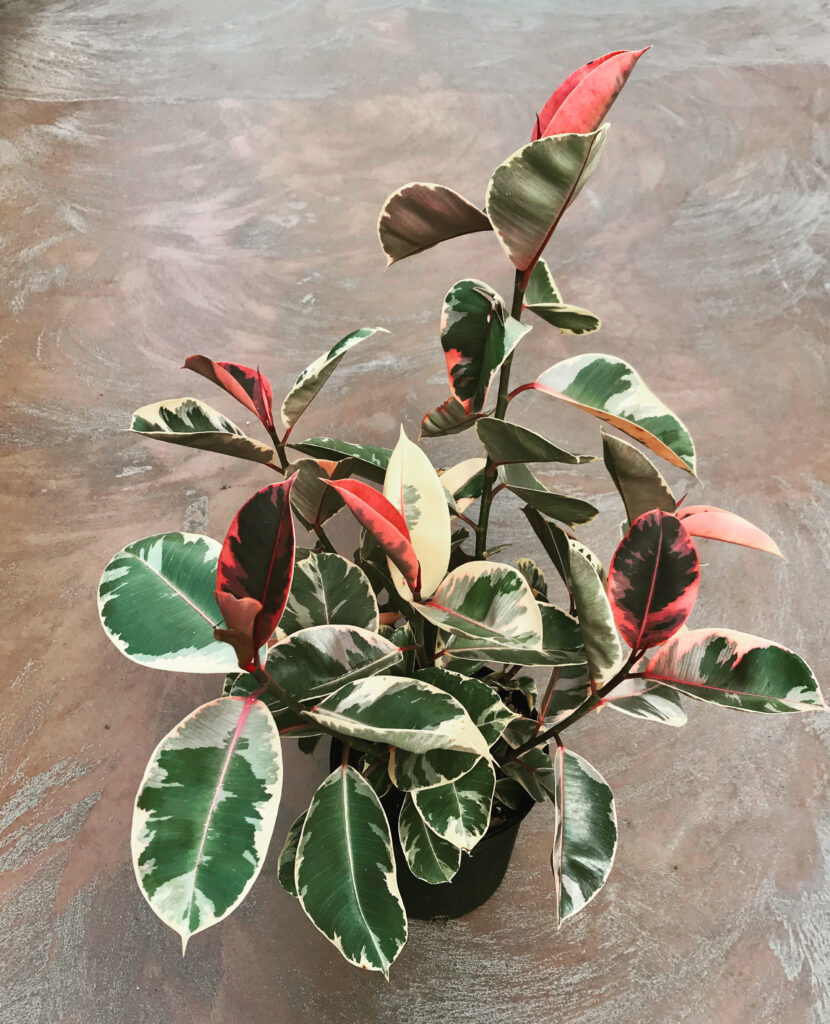
Humidity: All ficuses like humidity but Ficus elastica really love it. Ample humidity keeps leaves supple and from drying out on the edges. Adding a humidifier during the winter helps everyone, including your skin.
Feeding: I actually don’t feed Tilda any fertilizer. I do feed Rudy this fertilizer during his growing season (April-September) but variegated plants can suffer if they’re overfed. For some reason, they are more likely to get fertilizer burn which is sometimes mistaken for lack of humidity – dry crispy leaf edges or brown leaf spots. If you want to fertilize, just be sure it’s diluted enough.
Are Ficus’ Toxic To Pets?
Yeah, kinda. In my Rubber tree post that you should read, I say that Ficus elastica and Ficus tineke are toxic to cats and dogs. And they are, kind of. Because of the general unpleasant rubbery texture, my cats avoid them. The toxicity issue for cats, dogs or hungry children stems from the milky sap that excretes when a leaf is removed. This is what causes irritation and is ultimately why variegated rubber trees (and regular) are considered unsafe.

Ficus Tineke Problems
As I mention above, I found that my Ficus tinieke suffers more issues than Rudy, and I attribute it to the variegation. Here are some problems I’ve encountered and some ways to fix them:
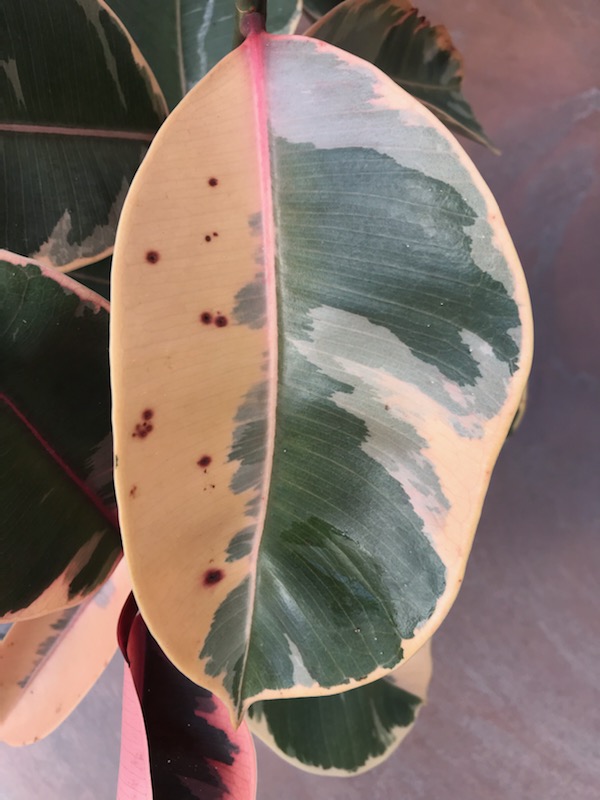
Brown Spots: Oh, the dreaded brown spots on Ficus tineke. Almost every variegated rubber plant I see has some kind of brown spots (above), whether dry edges on leaves or damage in the middle of leaves. Rubber trees like humidity and dry air can cause these brown spots or dry tips. Harsh direct sun hitting the leaves can scorch them leaving unsightly blemishes even Sephora can’t cover. Also, be sure you aren’t over-fertilizing.
Dull leaves: Spider mites and thrips are the worst offenders for rubber trees. Rudy was hit with spider mites BAD and finally recovered but was left with dulled leaves with a metallic sheen on the underside. Cloudy, matte leaves or gently pitted leaves are symptoms of either spider mites or thrips, so a flamethrower and/or insecticide is necessary to combat them.
Mushy Stems: Rubber trees, especially ficus tineke, don’t like irregular watering. Too much water and you’ll get root rot, which is gross. A mushy stem or funky smell can indicate root rot. If you suspect any, rent a hazmat suit and inspect roots asap, trimming away any dead roots.
Yellow Dropping Leaves: Too much water. Ease up on the water.
Slow Growth: Is typical. These guys do grow a lot slower than green/burgundy rubber trees, even under superb conditions. Pests can also hinder growth, so it never hurts to get out your magnifying glass or monocle and do a bug check.
Changes in Variegation: The beauty of variegated leaves is that the are all different. You may get a leaf with very little white and you may get a completely white leaf (below). The important thing to remember is that leaves stay healthy, no matter what they look like. Variegated rubber plant leaves should always emerge ruby colored and not deformed. For more contrasting variegation, set your plant in a place with a cooler temperature.

Where to Buy A Variegated Rubber Plant
Variegated rubber plants can be difficult to find; apparently they are very popular in Sweden, but if you’re not in Sweden then there’s always the interwebs. If you can hunt one down locally, even better!
Once you do get your hands on one, they’re easy to propagate. Follow my guide on how I propagated a mini Rudy here.
This post contains affiliate links.

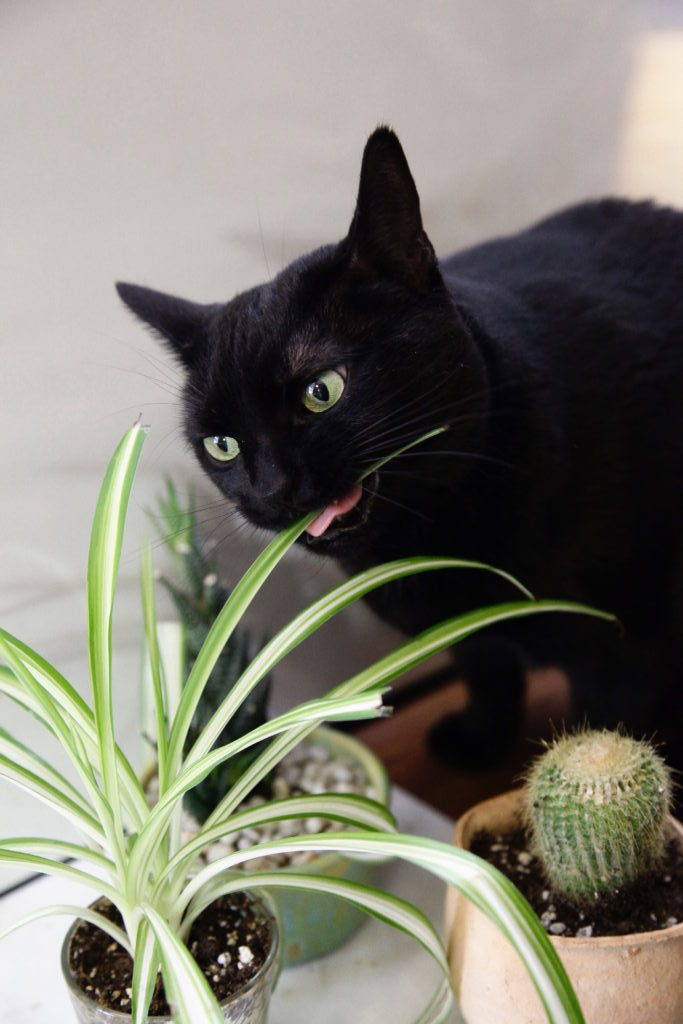
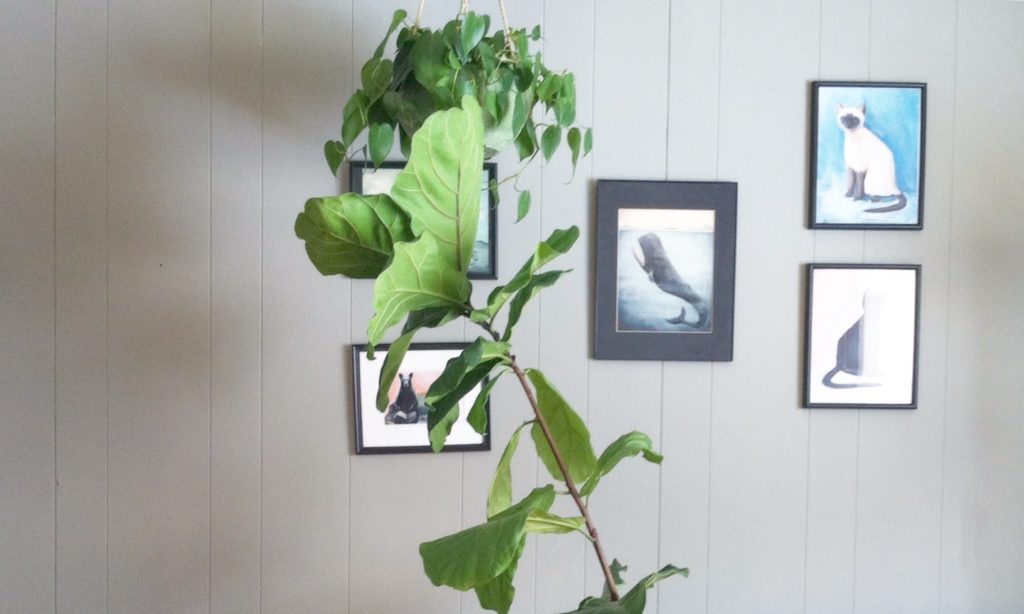
I’ve been keeping my eyes open for a rubber tineke. My question is. I’ve seen some little ones for sale that seem to be just about all green leafed. Do they not get the variegation until they are more mature or are these plants mislabeled or possibly a different variety?
Thanks,
Hi Whitney, nope Ficus tineke’s have the variegation when they are very young, they never start green. Their young leave are usually pink. There’s the regular rubber tree, which has all-green leaves that stay green, so I’m thinking it was mislabeled.
Hi, I am a new rubber plant lover and both my tineke and ruby has small dots on one or two if their leaves. Both are only about 6 inches tall. What’s the problem with those small dots?? Thanks.
Hi Jai, Spots can be number of things, either scale bugs, watering inconsistencies, or a fungal infection. Feel free to send me a pic of Instagram or FB, but you should check for bugs and be sure you aren’t overwatering or letting them dry out too much.
I bought a gorgeous 5 foot multi trunked very full variegated rubber plant (I presume its a Tineka). I’m in love with this plants impressionistic watercolor markings, reminds me of Monet paintings. I think the plant knows how much it takes my breath away every time I look at it (lol). Anyway I’ve had it for maybe 6 months and have started noticing a few of the leaves have developed the brown spots you mention in your article only my plants spots are singular and more large almost like its singed. Its only afflicted a few leaves so I’m not devastated by it yet but do want to address what I might be doing wrong so I can put a stop to it. The plant is in a 5 gallon nursery pot which is inserted into a raised mid century modern look planter. Removing the plant from the container is very difficult so I got a container liner that the nursery pot sits on inside the container. Because of this I am careful of only watering a small amount at a time – like a quart and only water a couple times a month. I only use distilled water. Because we are in the growing season I used liquid Miracle Grow Houseplant food mixed in the water a couple times. I water only infrequently because I know rubber plants don’t like too frequent waterings but I do thoroughly spray mist the plant a few times a week. The plant sits in a corner next to a window so it gets bright indirect light. Can you tell me if its the fertilizer, watering amount/schedule, or what could be causing the large brown spots on some of the leaves? I don’t think its pests because I got the plant from a specialty plant store that only sources from a quality indoor nursery. Thanks for your help.
Hi Stevan, I found your problem immediately – watering. Almost all plants prefer a deep soak less often than small, unsubstantial watering more often. Also misting is not necessary for these plants and can even cause the brown spots. So here’s what you need to do: do a deep watering every week or so (whenever soil is 90% dry) and water until it comes out of the bottom of the planter hole, halt misting, and cut the fertilizer down to once a month. Miracle grow can be kind of strong, so I also recommend you dilute that and only use half the suggested amount. You may lose some leaves during this transition, but not correcting it would result in a sad plant. Good luck!
Hello! I found your post very helpful. I’ve been searching around trying to figure out what I should do. So I’ve taken over my MIL’s rubber plant (at least I think that’s what it is) and it is looking very sad. I would like to save it. I’ve just repotted it today into a slightly bigger pot with a drainage hole and put it back by the window. It has dark brown spots on the tops of the leaves and underneath as well. Should I trim these leaves off? It would only leave about 4 baby leaves on the top if I trim all of them off. Is she salvageable? I am a newbie, please help! I’d love to send you a photo of it. Thank you in advance!!
Hi Tammy! Feel free to send a photo through Instagram or FB. First, these guys like to be a bit cozy in their pot, so I wouldn’t put it in a larger pot, that only creates the chance of root rot. Watering inconsistently (such as in small doses) and using hard water usually leaves brown edges. Try letting it dry out almost completely, then doing a deep watering. Wait until all water drains out (never let them sit in any) and you should be good. Usually these guys drink once a week and need bright light to do well.
Hello! I just bought (what i think is) a Tineke. But I’m really struggling with its care. It only had two leaves at first and the eldest leaf fell off. It had a bit of browning along it’s edges as well as a few brown spots when I first got it and I might have gotten a head of myself when I bought it. I was distracted because I finally found one. Now it’s down to one leaf and another really small one. Please help! Thank you ?
*its *ahead
Hi Catherine! These need to be in very bright light to do well, anything less and they struggle. Brighter light should make the plant pump out more leaves – also be sure to only water when it has dried out pretty well. Overwatering can cause leaf spots.
Hi there!
I just bought this type of plant- I inspected it, saw fine webbing at the base and immediately treated with neem and an alcohol mixture + watered. Overall it seems pretty healthy, just some brown spots on the undersides which combined with the webs I assume are due to spider mites.
It has the one leaf that’s curled and extremely matte and dry feeling- should I cut it off?
I would, Kait. If any one leaf has been very infected by bugs, I would cut it off, as long as the plant has many other leaves.
Loved your post! I am new to rubber trees (and new to plants in general) so I have lots of questions!
I just bought a variegated rubber tree (tineke) and I noticed one leaf in the bottom that was matte, almost completely grey and dull looking.
A few days after bringing it home last week, that leaf has fallen off. But I now have 3 new leaves and one of them (the oldest one) is not shinny… It looks fine color-wise but it’s not shiny like the others…
Is there something wrong with it or is this normal?
Thanks for your help!
Hi Angela! It sounds like spider mites, they end up turning a leaf matte and weirdly metallic looking on the underside. I would do a thorough check for any buggies and I would even spray with neem oil just to be safe. These ficus’ are prone to pests. In the meantime you can cut the matte leaves off and it will be fine, but keep your eye out for bugs or if any of the new leaves end up with the same damage.
Hi there! Can I send you photos of my Ficus Elastica Tineke through Facebook? She has developed some brown spots and just lost a bottom leaf. I’ve had her for a week and a half. I haven’t repotted her so she is still in her nursery pot. She had brown spots on some leaves when I bought her but she also had brand new growth on top so I bought her. The brown spots have grown and some smaller brown spots are developing on higher leaves. I’m devastated because I waited so long to find this plant! I haven’t watered her yet. On the day I bought her, my moisture meter read 10/10 for moisture—she was soaked. Now, a week and a half later, it reads 4/10. For most of her time here she has sat in indirect light, about 8 feet from an east facing window. Three days ago, I installed a Soltech grow light in the ceiling above her, although I think the brown spot spread occurred before the installation of the light. I can send you photos but please please help!
Hi Alaina! You def can, on either instagram or facebook. So brown spots are oddly common on these plants but usually affect mature leaves or all white leaves. Being completely saturated probably didn’t help, but they also like quite a bit of sun and I would recommend more than you are giving her. I would put closer to the window and keep the Soltech light. She is probably just adjusting but brighter light will help. I’m thinking the bottom leaf fell off because of too-much water.
Hi Anastasia,
Thanks for the very helpful article! I bought a Tineke few months ago because of its white variegation but now the new leaves are coming more green. Is there a way I could make it more white? I tried putting it outside and it burnt instead. Now I’m trying to keep it closer to the glass door.
Hi! These do need bright sun but not direct sun, which will burn leaves. Right up against a window should be perfect! You can cut any very damaged leaves off.
Hi, thank you for the post! I’ve had my Ficus Tineke for over a year now, and haven’t had too many issues. I moved recently, the new window no longer has direct morning light, but all day indirect light. I also changed it into a much larger pot about one and half month before the move. The new sheaths have been coming out as light green instead of red, the new leaves are lighter in color and smaller in sizes. Is it safe to say that it’s not getting enough light? Would it readjust after a while? thank you so much!
Hi Pei! Yes definitely, these like a lot of light and sometimes too-big of a planter can hold just too much water. They key for these is lots of light and letting them dry out thoroughly between waterings.
Hello!! I have a baby tineke, 6 small leaves, used to be 7, but one leaf had black spots so i trimmed it off. 2 other leaves have a few spots, recently, they’re developing brown parts of the 2 leaves with spots already… they are middle leaves
I just bought a sansi 15W grow light, and they are initially a bit at the middle of the light.20 inches or more between the light and tjneke. It’s grouped with my other rubber trees and monstera and dumbcane.. my 2 other rubber trees are fine. But my monstera has a brown small patch on 2 leaves, with a bit yellowing around it. And also there’s a humidifier a few feet away from them above. Not directly hitting them. I’m so confused. Help?? ?
Hi Sweeney, your tineke may not improve and get worse before it gets better. Usually those “brown spots” show up and end up ruining the leaves. The spots typically show when there’s been inconsistent watering or not enough light. That said, the issues you are experiencing sound like watering, not light. Be sure you are just keeping all of the plants lightly moist but never consistently wet, and you are not letting the monstera or tineke dry out completely. As far as the light, I saw that plants needed time to adjust when I installed mine (I have a Soltech Solutions light) so they may need more time. If it makes you feel better Tinekes are so incredibly fussy, so don’t feel bad!
Hi there! I have a ficus tineke that I bought almost a month ago. It’s in a 10” nursery pot, within a decorative pot. It’s beautiful, but it gives me such headaches. The stem is nice and hard, i water it no more than one every 1.5 weeks, and mist it occasionally since it is very dry in my apartment during the winter. Like you, it’s by a southwest window a few feet away. However, it’s leaves are browning along the edges. A few leaves have even gotten brown crusty areas within the leaf itself. About three leaves have now fallen, though it’s a fairly large plant. When I bought it, it came fairly root bound, but I’ve been told to wait until spring to transplant it. I’ve checked for bugs, and I don’t see to have any (though admittedly, there is the occasional gnat flying around in my apartment). I don’t know what to do 🙁
Hi Sharlie, yup Tinekes are the worst and the browning always happens, even in greenhouses. They just aren’t great houseplants and are very finicky. They need a lot of sun (like a lot) and to be kept fairly humid. Mine only did well in a window in the bathroom and nowhere else. I would up the humidity and relocate if necessary so he’s in the warmest location you can find.
Hi Anastasia,
I have a variegated rubber plant that is about 25 years old. It was getting tall and gangly so I decided to prune it. I just lobbed off the main stem at the height I wanted the plant to be. New stems grew from the base of the plant but the leaves are very small. Now half of the plant has normal large leaves and the rest of the plant has leaves that are only half the size of normal leaves. The plant looks unbalanced, with the normal large leaves on the top and spindly stems with small leaves at the bottom. It is about 42 inches tall and is in a 14” clay pot. Is there a way that I can fix this?
Also, what is the best way to control scale insects? I water the plant about every ten days and I mist the leaves daily.
Thank you for any advice you can give me!
Deb
Hi Deb, so to answer the leaf question, new leaves on a pruned plant are always smaller. There’s not anything you can do about this, but placing in bright sun and a warm room will yield the best chance at bigger leaves. You can prune some of the other stems, but honestly, I’ve had this unbalanced plant look and just went with it until more leaves filled in. Then I reassess and prune again if needed. As far as scale, I manually pick them off and follow up with a good insecticide – I usually use a Bonide product. Scale is easy to get rid of, you just need to be diligent and pick them off regularly.
I have a small tri color and small variegated could I plant them in the same container thank u
Yes you can!